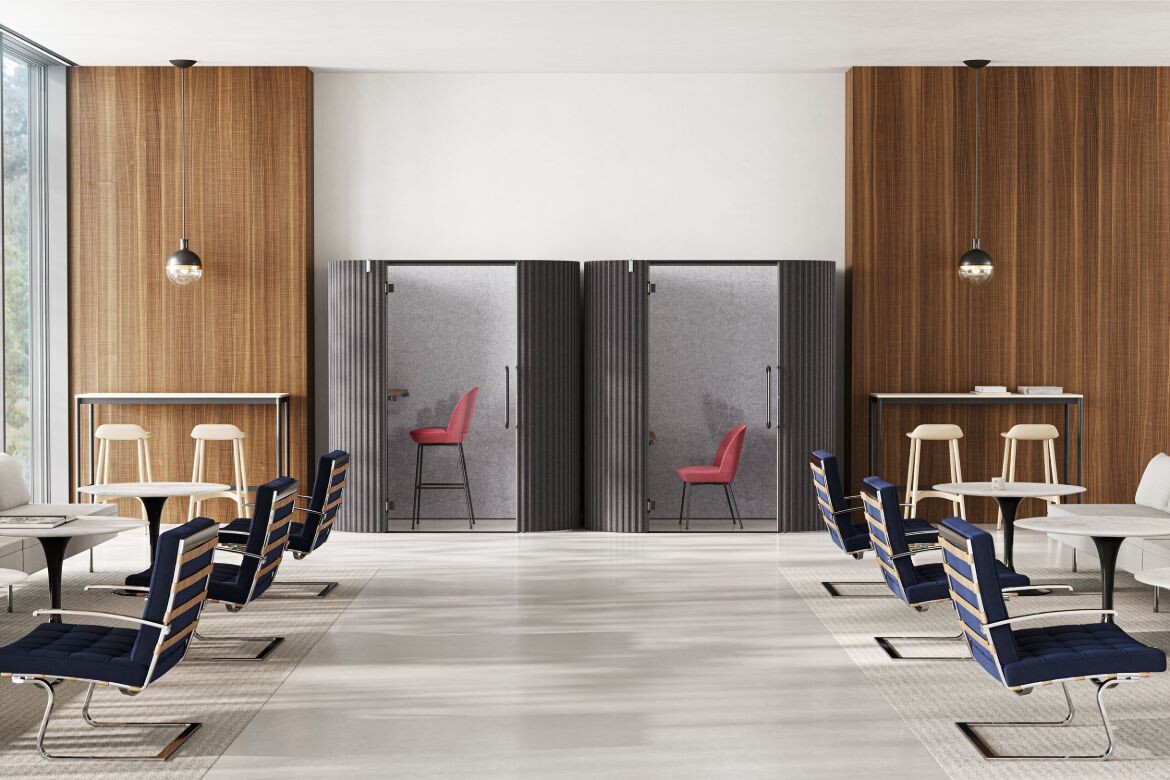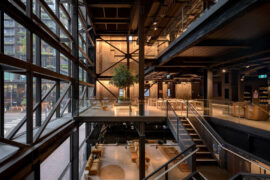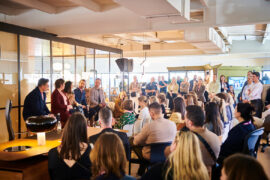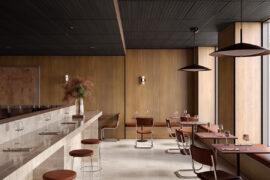How can design empower the individual in a workplace transforming from a place to an activity? Here, Design Director Joel Sampson reveals how prioritising human needs – including agency, privacy, pause and connection – and leveraging responsive spatial solutions like the Herman Miller Bay Work Pod is key to crafting engaging and radically inclusive hybrid environments.

May 26th, 2025
When I first meet Joel Sampson, Siren Design’s Design Director, it’s on my computer screen, 10 minutes into our scheduled meeting. He’s in Melbourne, nestled within the inviting hum of the studio, while I’m navigating a minor technical glitch in my NSW home office. This blend of physical distance and virtual presence – punctuated by the occasional logistical hiccup – poignantly accentuates the core of our conversation: the profoundly evolving nature of workplace design in the age of hybrid work and the fundamental truth that – as Joel so succinctly puts it – “work is now an activity, not a place.”
This immediate context sets a relatable stage for an intricate exploration of how design can support diverse human needs across a decentralised work landscape, and as a leading voice in workplace design, Joel offers a distinct point of view, honed over two decades of experience in dynamic markets like Singapore and Shanghai as well as Australia. Surpassing rigid design approaches, Joel’s ethos focuses on creating spaces that authentically reflect their inhabitants. This philosophy values understanding over imposition and prioritises purposeful design over unnecessary complexity. “Oftentimes, the simple ideas tend to be the most effective,” Joel smiles, revealing the essential principle underpinning his appreciation for unpretentious, innately functional solutions.
Flexibility as control
Applying this ethos to the complex reality where the lines between “work” and “place” continue to blur, Joel notes that the essence of flexible work lies in the notion of agency. “Flexibility in the modern workplace means giving people control over how and where they work best,” he explains. And while he appreciates the dynamic culture of Siren Design studio, he admits that some of the most impactful design decisions strike him at the gym, reinforcing the notion that peak productivity – or flash of creativity – can be entirely untethered and occur anywhere.

As such, it’s essential to appreciate the team’s spectrum of needs and preferences – and prioritise tailored, insight-driven solutions over universal hybrid models. “I think everyone needs to have a choice and I always encourage our clients to workshop that together at the start of the project,” Joel says, emphasising that co-creation and understanding user needs upfront is crucial for crafting responsive environments. “Once organisations figure out where they work the best, we can create a space that really works for them.”
The social magnet and digital overlay
With this increased focus on flexibility comes a fundamental recalibration of the physical workplace. If work can happen anywhere, is there a reason to go into the office?
“When I come into work, I don’t want the solitary environment of my home workspace,” Joel, who works at the studio five days a week, explains. “It’s about talking to people, exchanging ideas, sketching together. That’s how I see the workplace evolving – it becomes this social magnet that brings people together. That’s the reason to come into the office.”
This powerful gravitational pull towards connection necessitates a design approach that prioritises interaction and collaboration. However, Joel is quick to point out that physical office space isn’t the only one designers should be concerned with.

“Working from home is a completely unique experience, which might make people feel detached,” he says, explaining that hybrid work might create a disjointed, two-tier experience. “It’s critical to design physical spaces and implement digital protocols that actively support inclusive collaboration, ensuring everyone feels equally connected and has the same access to opportunities, regardless of their physical location.”
This, Joel says, requires a robust “technology overlay,” where the design of physical spaces is intrinsically linked with the digital systems that facilitate seamless interaction. “It’s essential to reinforce both digital and physical environments,” he emphasises. “They’re equally as important.”
The rise of “getaway spaces”
Beyond this emphasis on ubiquitous inclusivity and human connection, the hybrid workplace intensifies the long-standing requirement for individual space within the office environment.
The traditional open-plan model, while intended to promote a sense of community, often falls short in providing the necessary quiet for deep concentration, confidential conversations or virtual meetings – tasks that remain crucial in any work setting. And while Joel is noticing a clear shift away from large, formal meeting rooms towards more casual settings and staff hubs, he’s also observed a significant increase of Zoom rooms, where the casual and quiet seamlessly converge, yielding efficient nooks of privacy amidst the unavoidable office buzz. “The ability to step into those quiet ‘getaway spaces’ to do some work, jump on a call and interact with people is essential,” Joel explains.

An unassuming cocoon of versatile privacy
It is precisely by addressing this critical need for casual, private space within the dynamic open plan that solutions like the Bay Work Pod become not just relevant, but necessary. Anchored by Herman Miller’s commitment to human-centric design, the Bay Work Pod is optimised to support the realities of hybrid schedules and open environments by providing an inconspicuous cocoon of versatile privacy.
In fact, Joel points to that minimalist aesthetic as one of the Pod’s most appealing qualities – the simple, rounded form offers the kind of quiet subtlety other pods have so far failed to deliver. “Even its finishes – the corrugated material on the outside and the frosted doors – are quite refined,” Joel says, relating the pod’s expression to his own affinity for simplicity. “Pods shouldn’t be these big, flashy, over-the-top structures. They should be tucked away, offering accessible privacy without disrupting the office landscape by attracting unnecessary attention.”
Shaping the open-plan landscape
The Bay Work Pod’s deliberately unimposing design seamlessly harmonises with various workplace aesthetics without becoming a jarring visual element, while its inherent mobility reinforces the pod’s strategic potential to transform the workplace into a responsive ecosystem.
Joel explains that, in contrast to fixed pods that are disruptive to relocate due to integrated building services, the Bay Work Pod’s nimble, lightweight and self-contained nature allows workplaces to be particularly reactionary. Layouts can be quickly reconfigured based on evolving team needs or optimised in line with utilisation insights, a scenario which Joel thinks will become increasingly more relevant as the confluence of data, analytics and AI delivers more actionable insights on human behaviours and utilisation patterns.

This strategic movability, the preference for which Joel noticed during his time in China, offers powerful possibilities for shaping the physical landscape of an open-plan office. “You can place the pods in more discrete settings, but you can also use them to zone out specific areas, creating visual and acoustic separation between different workspaces,” he enthuses. “You could even position them in the middle of a floor full of workstations to curate a more engaging and functional landscape within.”
Designing for the full spectrum
Alongside the Pod’s outstanding ability to dynamically augment the functionality of a modern office, Herman Miller’s flagship solution addresses the imperative for inclusivity and wellbeing in contemporary workplace design.
“Designing for the full spectrum of human needs, including neurodiversity, isn’t necessarily about radical, specialised interventions,” Joel says. “Rather, it’s about integrating a broad spectrum of different types of spaces, from quiet zones to more vibrant environments, to cater to varied sensory sensitivities, work styles and preferences.” Joel adds that this diversity should be underscored by the individual flexibility to customise the workspace. “Whether it’s temperature or lighting,” Joel says. “The ability to control these aspects is essential.”

The Bay Work Pod’s standard as well as ADA-compliant Pro variant, which boasts larger interior and flush floor entrance for ease of access for wheelchair users, contribute significantly to this spectrum by providing a controllable and calming environment. Features like dimmable lighting and a discrete, user-controlled fan allow individuals to curate their immediate surroundings. In addition, juxtaposing harsh lighting, jarring finishes and overwhelming patterns – all of which, Joel says, can be overstimulating – the Pod’s soft, tactile and unobtrusive fit-out ensures a less overwhelming sensory experience.
Simultaneously, Joel emphasises the vital role of movement and the ability to adjust one’s posture throughout the day, linking them to productivity, physical comfort and overall well-being. Recognising this requirement as particularly crucial for neurodivergent individuals or those who require physical flexibility in their working position, the Pod’s ample interior accommodates a range of ergonomic seating options, including Herman Miller’s dynamic performance chairs designed to reflect the natural movements of the human body. This allows users to embrace motion while maintaining optimal comfort and support, aligning physical well-being with the need for focused work.
Taking a pause
Joel also highlights the importance of dedicated areas for de-escalation and quiet reflection, acknowledging the need for mental respite as vital for overall wellbeing and supporting neurodiversity. Whether it’s a quiet pod or a dedicated wellness room, the concept of “pause spaces” that offer individuals a moment of stillness is critical in inclusive design. “It’s essential to create these pockets of respite for times when the environment gets too overwhelming,” Joel explains. “Being able to escape into a gently-lit, calming space to take a moment can be incredibly helpful.”
With its inherent ability to provide a secluded, controllable environment, the Bay Work Pod can certainly function as a valuable component within a broader strategy for providing the essential instances of “pause.” Plus, the Pod’s discreet occupancy sensor, which Joel highlights as a particularly smart feature, further enhances its usability by simplifying the process of finding an available space, reducing the potential anxiety associated with searching for a quiet spot and yielding a more seamless and easier-to-navigate environment. It’s yet another subtle design detail that supports a less stressful and more empowering user experience.

Untethered design that celebrates individual choice
Looking ahead, Joel firmly believes that – driven by the undeniable value of individual choices – hybrid work is here to stay. However, he reinforces his conviction that the future of workplace design lies not in mandating rigid models, but in providing diverse, adaptable and tailored solutions that authentically empower individuals to choose the environment best suited to their task, preferences and wellbeing at any given moment. “Hybrid work’s success is rooted in how people want to use the space,” he adds, noting that in Australia, commitment to individual agency is particularly valued.
This fundamental focus on choice and adaptability will be essential to navigating the evolving landscape of the modern workplace, and Herman Miller, as part of the wider MillerKnoll collective, emerges as a crucial enabler and thought leader actively shaping not just the conversation around the future of work but the future workplace landscape itself.
“I appreciate that Herman Miller and MillerKnoll are delving into the theory of the workplace, moving beyond merely selling furniture,” Joel reflects. “There’s a sense of it being far more considered and, frankly, more interesting. I believe they’re genuinely exploring the way that humans actually work.”

This deep exploration inherently recognises that in a world where work is an activity increasingly disconnected from a single location, and the concept of place becomes progressively fluid, the need for dynamic spaces that can swiftly respond to diverse and evolving human needs becomes paramount. This is precisely where innovative and equally nimble solutions prove essential – and the Bay Work Pod stands out as a particularly compelling untethered design solution for an untethered workplace.
Unassuming in its visual expression, the versatile, responsive, accommodating and customisable Pod embodies a multifaceted spectrum of needs, preferences and requirements in a surprisingly uncomplicated yet dynamic form. More than just the perfect getaway space, the Bay Work Pod emerges as a crucial articulation of inclusive empowerment in the fluid workplace ecosystem, enabling all individuals to do their best work whenever, wherever – and however.
Locate your nearest MillerKnoll dealer, Australia’s exclusive destination for Knoll’s designs, to elevate your next project with an iconic piece embodying exceptional material legacy, enduring craftsmanship and inherently relevant design.
INDESIGN is on instagram
Follow @indesignlive
A searchable and comprehensive guide for specifying leading products and their suppliers
Keep up to date with the latest and greatest from our industry BFF's!

The undeniable thread connecting Herman Miller and Knoll’s design legacies across the decades now finds its profound physical embodiment at MillerKnoll’s new Design Yard Archives.

A longstanding partnership turns a historic city into a hub for emerging talent

Tzannes has completed work at The Brewery in Sydney’s Central Park, marking the culmination of an internationally significant adaptive reuse project.

Curated by the Indesign editorial team and hosted at leading showrooms, the Design Discussions series provided thoughtful reflection and debate on key issues shaping the industry.
The internet never sleeps! Here's the stuff you might have missed

Australian designed and manufactured, Laminex Architectural Panels transform timber design aesthetics with cutting-edge technology

For Aidan Mawhinney, the secret ingredient to Living Edge’s success “comes down to people, product and place.” As the brand celebrates a significant 25-year milestone, it’s that commitment to authentic, sustainable design – and the people behind it all – that continues to anchor its legacy.